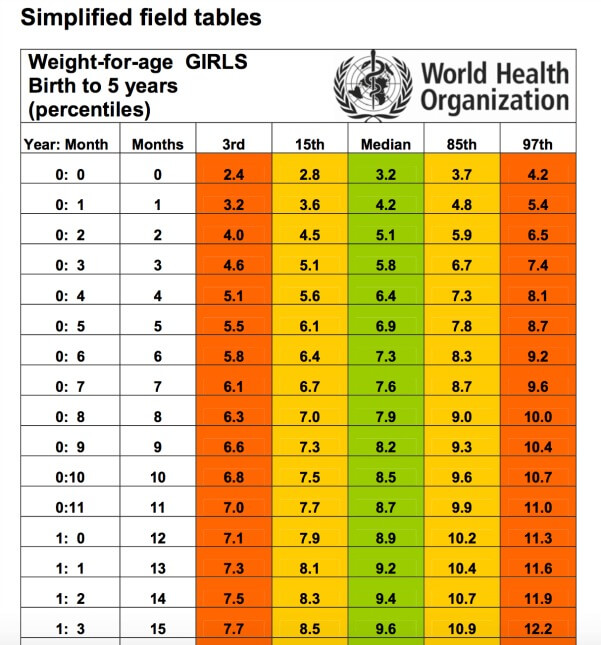Indian Baby Weight and Height Chart Calculator
WHO baby growth tracker
How to read WHO weight and height charts
Indian Baby Weight & Height Chart Calculator – One of the most common concerns that we receive from parents is if their child gaining weight and height appropriately. What causes them most distress is when they see another child from their family or neighbourhood who appears to be growing much more in weight and height, more often weight.
In India, it is common to equate fat or chubby with healthy and lean weight with unhealthy specially in case of babies. We thought we will put to rest the concerns of parents with this article and baby growth calculator and explain how children across the world and in India grow in weight and height.

First of all, the commonly available growth charts by CDC are based on data for affluent babies in U.S.A., hence it is not right to compare your baby with those numbers. WHO provides charts which are more universal and we have used those to build these weight and height chart calculator and also to explain what the weight and height numbers mean and how to read those charts.
What to remember when checking weight and height chart of an infant:
- It is important to know that you cannot compare a girl with the boy the same age
- The charts given are from 3rd percentile to 97th percentile.
- It means that 94% of babies fall between these ranges of weight and height and are considered to be growing normally.
- The growth in weight and height is directly linked to birth weight and birth height. So a small 2.7 kg baby will not suddenly become same as 3.5 kg baby at the age of 1 year. The birth weight and height depend on many factors including genetics.
- These percentages are not likes grades in school. So, higher the better does not work here.
- Overall growth over a period of time is more important than weight at a particular time.
- If your baby is off the charts, i.e. below 3rd percentile and above 97th percentile, then there is cause of concern and you must check this with your baby’s doctor about the weight and height.
You may like:
Weight and Height chart for 2-12 years old girls
We will first have a look at the simplified charts given by WHO for infant girls and boys.
WHO weight & Height Charts for girls and boys
WHO weight chart for girls

WHO weight chart for boys

- In this chart the first two columns show the age. 3rd column is the lower range of weight in baby girls, i.e. in the 3rd percentile. It means 3% of babies will be below this weight curve.
- The second column is 15th percentile, which mean 15 percent of babies will be below thisthis weight chart. For example, my daughter whose birth weight was 2.7 kg will be under 15th percentile and her optimal weight at age of 12 months in 7.9 kgs. There is no point comparing her with a baby who is following 50th or 85th percentile.
- Third column is median or 50 % of the babies are below this growth chart.
- Fourth column 85th percentile, which means 85% babies are below this weight growth chart or 15 % of babies are above this weight growth chart
- Fifth column is 97%, which means only 3% babies are above this weight chart.
It is important to understand that this whole range is considered normal. Now, to know if your baby is growing optimally, your doctor will track baby’s weight from birth this now. If baby is following the curve s/he is thriving. If the baby falls off the charts, it is called failure to thrive.
Baby Weight and Height growth chart calculator
To aid you in calculating your baby’s growth chart, we developed this Baby Weight and Height growth chart calculator.
Baby Weight & Height Growth Chart Calculator helps you in tracking where your baby stands vis-a-vis WHO standards. This is an educational tool and these charts are only for reference and overall growth through a period is more important than baby’s weight or height at a particular point.
How to read the weight and height charts?
This tool is only for educational purpose and there is no need to worry or lose your sleep if you baby seems to be in lower percentile. Each baby is different and follows her own growth curve. Growth also depends upon ethnicity, geography and most importantly heredity. So if one of the parents or both parents of a baby boy are short, he will be shorter as compared to another boy of same age whose parents are taller.
There will also be some highs and lows during the course of first 2 years. But if you see sudden drop in weight or height, say from 95th percentile to 25th percentile, refer to your doctor immediately as there could be some illness or other reason to this.
These percentiles are a way of showing how your baby is growing as compared to an average growth of other babies. The chart used here is provided by WHO.







Hi Priya, thanks for these calculators. They are so informative and easy to use. However, we can’t see the graph bayond 1 year of age on the phone at least. Please check.
Growth chart should be based on birth weight. One size doesn’t fit all. Human beings are different.
That’s true, Prassoon. These are average values shared by WHO based on a wide spectrum of children.
My dogthr growth whery poor no whaking please tell me